| Columns Retired Columns & Blogs |
I suggest (edit: I removed my erroneous suggestion).
I used DRA Labs' MLSSA system and a calibrated DPA 4006 microphone to measure the Marten Parker Trio Diamond Edition's frequency response in the farfield, and an Earthworks QTC-40 mike for the nearfield and in-room responses. I measured the speaker's impedance with Dayton Audio's DATS v2 system.
Usually, I measure loudspeakers in our backyard, weather permitting, or in our living room with the furniture pushed to the sides. This eliminates or moves back in time the reflections of the speaker's output. However, as this loudspeaker was too heavy for me to move outside or upstairs to the living room, I performed the quasi-anechoic measurements in my basement listening room. I managed to maneuver one of the speakers, standing on its IsoPuck bases, onto a small, wheeled dolly and rolled it forward so that it was aimed across the room's diagonal and was as distant as possible from the nearest sidewall. However, the proximity of room boundaries, the floor in particular, meant that I had to window the time-domain data a little more aggressively than I usually do. This reduces the measurements' resolution in the midrange. The geometry of my listening room also meant that I could only measure the horizontal dispersion over a ±45° angle rather than my usual ±90°.
While Marten specifies the Trio Diamond's sensitivity as a high 91dB/2.83V/m, my estimate was significantly lower, at 86dB(B)/2.83V/m. (I noticed I had to set the volume control about 3dB lower than when I listened to the 83dB-sensitive Falcon Gold Badge LS3/5a's Herb Reichert reviewed in the April issue for the same perceived volume, which subjectively corroborates the measurement.) The Trio Diamond's impedance is specified as 6 ohms with a minimum magnitude of 3.1 ohms. According to my measurements, the impedance magnitude (fig.1, solid trace) remains above 4 ohms over most of the audioband, with minimum values of 3.3 ohms between 110Hz and 120Hz and at 2.9kHz. The electrical phase angle (dashed trace) is occasionally high, which means that the EPDR (footnote 1) drops to 2 ohms between 64 and 111Hz and between 1.7kHz and 2.8kHz, with a minimum value of 1.5 ohms at 83Hz and 2.2kHz. The Trio Diamond Edition should be used with amplifiers that don't have problems driving 4 ohms.
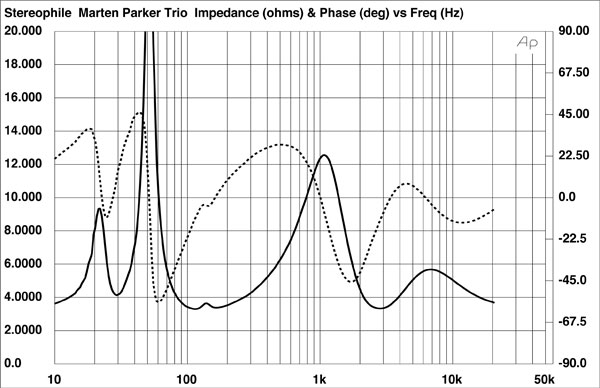
Other than a small bump centered on 140Hz, the traces in fig.1 are free from the small discontinuities that would imply resonances of some kind, but when I investigated the enclosure's vibrational behavior with a plastic-tape accelerometer, I did find some resonant modes. The strongest of these was at 855Hz on the sidewalls level with the upper woofer (fig.2). There was also a lower-level mode lower down on the sidewall and on the top and back panels. But because all these modes have both a relatively high frequency and a high Q (Quality Factor), it is unlikely they will color the Trio's sound. The metallic ringing sound I heard when I rapped my knuckles on the enclosure's sidewalls turned out to be due to the metal grilles that cover the woofers and passive radiators, the latter in particular. However, because the radiating area of these grilles is minuscule, this ringing will be innocuous.

The saddle centered on 29Hz in the impedance magnitude trace suggests that this is the tuning frequency of the passive radiators. The minimum-motion notch in the woofers' summed output (fig.3, red trace), which is when the back pressure from the reflex resonance holds the woofer cone still, lies at the same frequency. There is a small suckout in the woofer's output at the frequency of the impedance magnitude bump, which implies some kind of internal antiresonance in this region. The passive radiators' summed output (fig.3, green trace; both behave identically) has one peak centered on the tuning frequency of 29Hz and another an octave higher. The upper-frequency rolloff is initially clean, though some low-level hash can be seen between 200Hz and 500Hz. As the radiators fire to the rear of the loudspeaker, I doubt this behavior will have audible consequences.
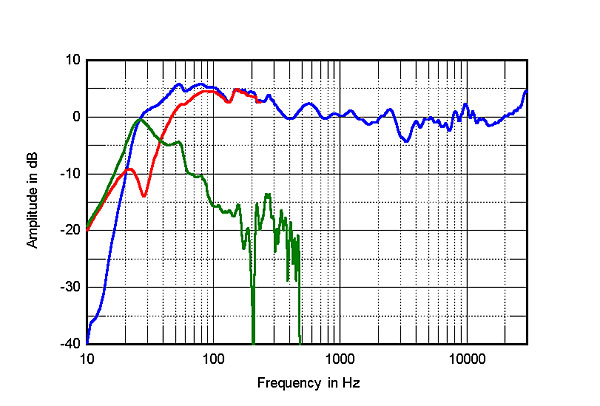
Looking at the nearfield outputs of the individual woofers reveals that the lower woofer starts to roll off above 300Hz, its output at 1kHz lying 10dB below that of the upper woofer. The blue trace below 300Hz in fig.3 is the complex sum of the nearfield woofer and passive radiator responses, with the latter's acoustic phase compensating for the fact that they are on the Parker Trio's rear. There is the usual peak in the upper bass due to the nearfield measurement technique, but the Trio definitely offers extended low frequencies. The Marten's farfield response, averaged across a 30° horizontal window centered on the tweeter axis (fig.3, blue trace above 300Hz), is even but with a slight lack of energy at the bottom of the tweeter's passband. This suckout was a little deeper with S/N 20103001B than it was with 'A. The tweeter's on-axis response starts to rise above the audioband, reaching a peak near 35kHz.
Fig.4 shows the Trio Diamond's horizontal dispersion, normalized to the response on the tweeter axis, which thus appears as a straight line. This graph reveals that the small dip in the lower treble in the on-axis response fills in to the speaker's sides, though the tweeter's output falls off rapidly off-axis. In the vertical plane (fig.5), a suckout in the crossover region develops more 5° above the tweeter axis, but the top-octave response doesn't drop off below the tweeter axis as much as I was expecting from my auditioning.
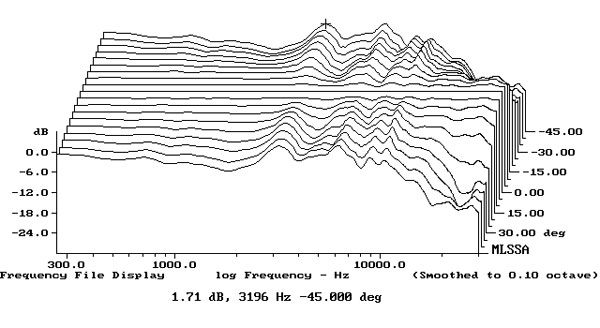
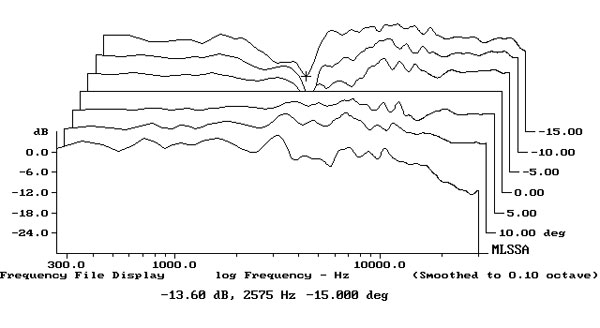
Fig.6 shows the Marten Parker Trio Diamond Edition's spatially averaged response in my room. (The spatial averaging, footnote 2, tends to average out the peaks and dips below 400Hz that are due to the room's resonant modes.) With its extended low frequencies, the Trio Diamonds maximally excite the lowest frequency mode in my room, but other than some small peaks in the upper bass and midrange, the balance at the listening position is impressively even, especially in the low and mid-treble. The Trios' output in the top two octaves slopes smoothly down; as I have written before, a loudspeaker that offers a flat on-axis response and well-controlled lateral dispersion gives a gently sloped-down treble in the spatially averaged room response due to the increased absorption of the room's furnishings and the narrowing of the tweeter's radiation pattern at high frequencies.
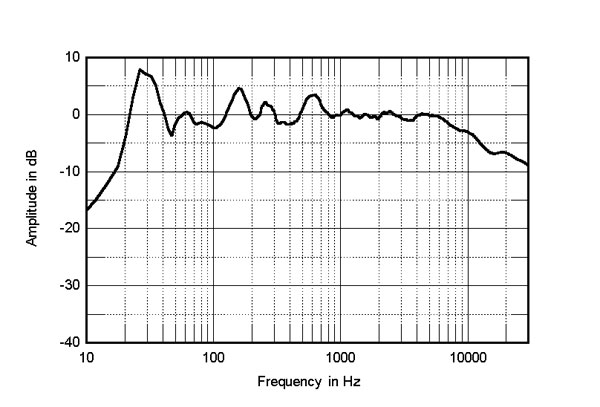
The standard Trios gave a very similar spatially averaged response from 40Hz to 12kHz in my room (not shown) but with a little more energy above 16kHz, and they didn't excite the lowest mode to the same extent as the Diamond Edition. Fig.7 compares the Parker Trio Diamond's spatially averaged response (red trace) with that of the Marten Oscar Duo (blue trace). The two loudspeakers behave similarly in the midrange. The Oscar Duos' top-octave output is a little higher in level than the Parker Trio Diamonds'. The Trio Diamonds have a smoother in-room response throughout the treble.

In the time domain, the Trio Diamond's step response on the tweeter axis (fig.8) reveals that the tweeter is connected in inverted acoustic polarity, the woofers in positive polarity. (I confirmed this by looking at the step responses of the individual drive-units.) The decay of the tweeter's step smoothly blends with the positive-going start of the upper woofer's step, suggesting optimal crossover design. There is a second low-frequency arrival around 0.5ms after the first, which may be due to the lower woofer. The Trio Diamond's cumulative spectral-decay plot (fig.9) is generally clean, though there are some decays of resonant energy visible in the lower treble. The decay is also slightly hashy-looking between 7kHz and 11kHz; I suspect that this is due to early reflections from the grille that covers the tweeter rather than to actual resonances.
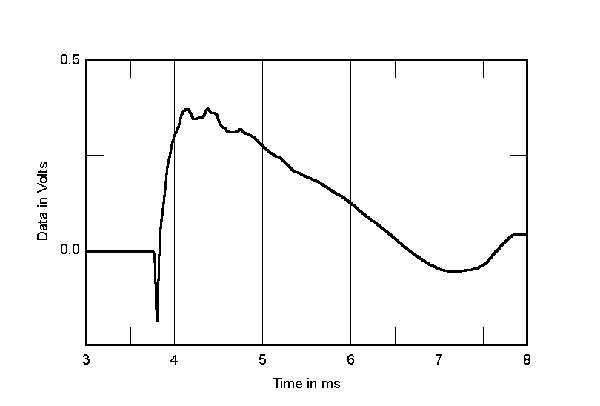
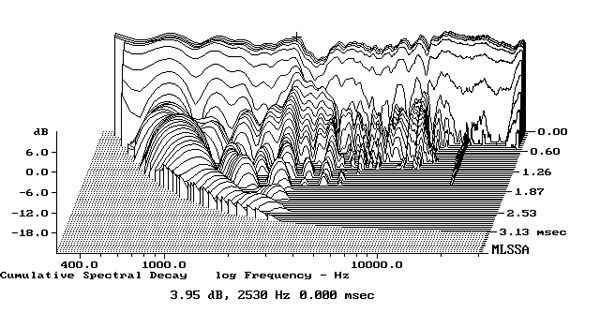
The Marten Parker Trio Diamond Edition offers generally excellent measured performance.—John Atkinson
Footnote 2: Using the FuzzMeasure 3.0 program, a Metric Halo MIO2882 FireWire-connected audio interface, and a 96kHz sample rate, I average 20 1/6-octave–smoothed spectra, individually taken for the left and right speakers, in a rectangular grid 36" wide by 18" high and centered on the positions of my ears.

I suggest (edit: I removed my erroneous suggestion).

John Atkinson
Technical Editor, Stereophile

It was intended as constructive criticism.
Keep up the good work.

in a $37,000 speaker. Doesn’t appear to be from a cabinet vibration, is it from the passive radiators?
And excuse me asking, but if the speaker is on a wheeled dolly, why can’t you fully rotate it to measure +/-90°? I couldn’t understand the explanation.
Looks like the voiced it well by adding a dip at 3.2Hz to combat the wide off-axis dispersion.
The bookshelf Duo measured around it’s stated sensitivity, so odd that this is so much lower than spec and barely higher than the bookshelf, the tweeter (BD 25-6-258?) is likely not the limiting factor.

I suspect that is an internal modal resonance, a standing wave. The apparent path length is a little longer that the internal height because the path includes delays and detours around internal bracing, woofer chassis, suspension and motor structures, passive radiator chassis and suspension structures, etc.
Speed of sound is oft quoted at 68 degrees Fahrenheit at approximately 343_m/s, and is 344 at 71, 345 at 74, 346 at 77, and is primarily dependent on air temperature. Air temps inside the enclosure will be warmer than room air while the loudspeaker is operating.
(343)/(140*2)= 1.225 meters
(344)/(140*2)= 1.229 meters
(345)/(140*2)= 1.232 meters
(346)/(140*2)= 1.236 meters
You can see some associated resonance in the passive radiator nearfield response, and more resonances an octave higher. The second order resonance is not showing in the impedance curve, perhaps because the geometry is not imparting a pressure node on the woofers where it would feed through the motor and be reflected in the impedance Though the lower woofer does appear as though it should be near a pressure node, unseen internal structures may be dictating something else.
You won't see that in a PR loaded subwoofer where internal paths are small relative to wavelength. But you will see it where PRs are utilized to load midwoofers operating at higher frequencies, shorter wavelengths (shorter than subwoofer wavelegths) in the taller enclosed air volume of a floor standing loudspeaker of a design lacking internal damping located in or near the velocity node positions of the internal modal resonances of the enclosure. Suitable damping is key, essentially using internal airflow resistance in those velocity nodes, effective at the frequencies of interest, but almost invisible at lower frequencies nearer the PR tuning. An example would be some SAE F13 sheepswool techical felt (maybe in combination with some Roxul Rockboard 80) sandwiched between a closely spaced pair of windowed shelf braces and some grill mesh or perforated steel for added support located at roughly 1/3 of the internal height where it would damp fundamental and second order standing waves in that path.

excuse me asking, but if the speaker is on a wheeled dolly, why can’t you fully rotate it to measure +/-90°? I couldn’t understand the explanation.
The problem stems from the fact that at angles greater than 45 degrees, there were reflections from nearby surfaces in my listening room that compromised the measurement.
John Atkinson
Technical Editor, Stereophile

Dear John Atkinson, at the first paragraph you wrote "at 6990$ those speakers aren't inexpensive..." and I was like, wow finally some sense! And then at the second page of the article it turned out to be 36,990$!!! And then I was like, ho, right.

The $6990 speakers were Oscar Duo's from a previous review. As JA describes in the early part of the article, we were first planning to review a much cheaper version but ended up with the version with the diamond tweeter, which is much more expensive. Very likely, the cheaper version is almost as good.
Jim Austin, Editor
Stereophile

I read the article again... I got it now... Would have been nice thou at 6995$ oh well :)

New loudspeakers come and go, often at exaggerated prices. 35 Years ago I had secured a pair of Yamaha NS-1000M's. For me they are still the best loudspeakers money can buy. Provided of course they are driven by first rate, preferably Class A amplifiers. Funny, their list price was only $1500.

Technology has advanced. You should listen to some of the newer better loudspeakers.

Not as much as you think...

Changes are RADICAL today compared to the 1970s when the NSM-1000M was designed. Materials improve, understanding of the physics improved, computer modeling/design software has made HUGE, nearly unimaginable changes compared to what was possible in the 1970s. Crossover design is massively better today than 50 years ago. Today's high quality electronic components did not exist in the 1970s. NON-DISCLAIMER: This is written by someone who recommended Yamaha NSM-1000s to three different friends in the 1970s who all loved them after their initial freak-out at the cost of them compared to the guy in the parking lot with a van full of big $25 speakers. I was well aware of how good NSM-1000s were in the 1970s. Why didn't I have NSM-1000s of my own? I was already a high-end idiot with speakers that cost 2.5 or 3 times more than NSM-1000s.

Computer software only mimics the principles and formulas published half a century ago.
Do you mean no greatly engineered products, structures or buildings could be built before computers?
As a structural engineer, part time professional software developer and an amateur loudspeaker system designer I tend to disagree. Nothing could be further from the truth.
BTW, Yamaha NS-1000Ms were not designed as an upgrade for white van loudspeakers.
They were produced as reference monitor speakers for highest quality recording studios worldwide and discerning audiophiles, regardless of price. They have highest technology in design and materials.

Loudspeaker enclosures are still designed with the formulas given by Thiele & Small (published 1960-1970). Crossovers are still designed by formulas given by Butterworth, Linkwitz-Riley, etc (equally old tech).
Actually, not much is new. (Except greedy manufacturers...)
And new doesn't always equal to better.
If you'll ever listen to Yamaha NS-1000M's, you'll understand what I mean.

Hey!
JA: "I kept being tempted to play music loud, though this meant that the huge bass drum hit 12 minutes before the end of Part Two of Gerontius scared the heck out of my cats, who were dozing on top of the speakers."
Reading that gave me a good chuckle, only cat owners would understand. Reminded me of my old cat, he used to hangout on my speakers also. Luckily he was careful getting up and down so I didn't have to worry about he tipping my speaker over.

Dear JA
I was wondering if you had any thoughts/experience with the quintets and how they compared to the trios?
Thx

I was wondering if you had any thoughts/experience with the quintets and how they compared to the trios?
I am afraid that I have never heard the Quintet.
John Atkinson
Technical Editor, Stereophile